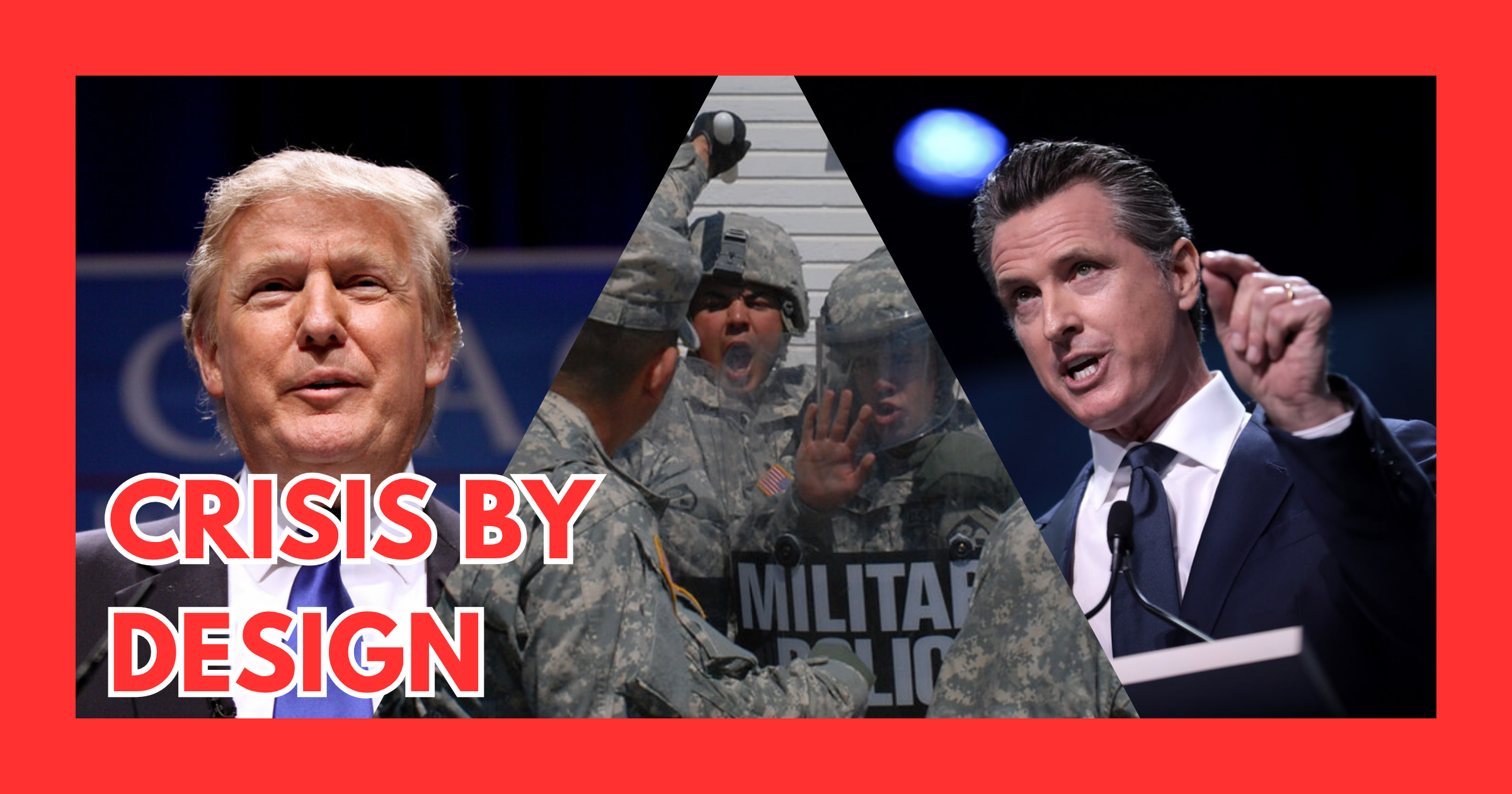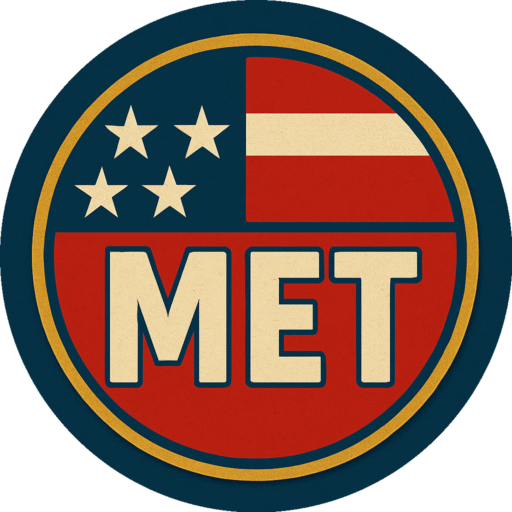
“Donald Trump” by Gage Skidmore is licensed under CC BY-SA 2.0 .
“California National Guard military police conduct law enforcement and leadership training” by Like us on Facebook at CAGuard is licensed under CC BY 2.0 .
“Gavin Newsom” by Gage Skidmore is licensed under CC BY-SA 2.0 .
Crisis by Design: Trump Frames ICE Protests as Migrant Uprising to Justify Military Response
Troops are on the streets. The reason why keeps changing.
by Met Middleson
June 9, 2025
Los Angeles is on edge. National Guard troops are patrolling the streets. Protesters have clashed with police, lit fires, and blocked highways in response to a sweeping series of ICE raids across the city. While law enforcement has described the crowds as “mostly peaceful,” the White House is telling a different story. President Trump has labeled the unrest a “migrant insurrection,” sent 2,000 federally controlled guardsmen, and warned of further force to come. His justification hinges on the idea of a foreign-led uprising, but most of the footage shows American citizens holding signs, not crossing borders. That dissonance raises a larger question: If the violence doesn’t explain the response, what does?
BURNING CARS, BROAD STROKES
There has been real violence in Los Angeles. Cars have been torched, storefronts vandalized, and police officers attacked with bottles and fireworks. Streets have been blocked, buildings evacuated, and tensions have flared into full confrontation in several neighborhoods. In some cases, protesters reportedly threw concrete at ICE agents and federal officers, and at least one Molotov cocktail was hurled during a confrontation outside a detention facility. The images are gripping and chaotic. They dominate headlines for a reason.
But those images, while undeniable, are not the whole picture. Much of the city has seen peaceful demonstrations. Crowds have included families, students, and longtime residents marching without violence. Protesters have gathered near detention centers, blocked traffic in organized waves, and delivered speeches denouncing the raids without crossing into destruction. Those acts of violence, while real, occurred alongside thousands of peaceful demonstrators who did not engage in any form of destruction or assault. The LAPD itself has acknowledged that., describing the protests as “largely peaceful” in official briefings.
That distinction has not carried over to the national stage. In the president’s telling, the city is overrun, the crowds are criminal, and the unrest is an imported threat. A handful of violent acts have been stretched to fit a broader narrative that demands force in response.
FROM DISSENT TO “MIGRANT RIOT”
President Trump has repeatedly escalated the language around the Los Angeles protests on Truth Social and X. He has called them a “migrant invasion.,” demanded the city be “liberated” from it, warned of “migrant riots,” condemned “insurrectionist mobs,” and even posted “They spit, we hit” before labeling the participants “paid insurrectionists.” This is not casual rhetoric. It is a deliberate reframing that positions dissent as a foreign-led rebellion and primes the public to view federal force as necessary rather than extraordinary.
Most protestors appear to be U.S. residents. Many are long-time Californians and participants in local activist movements. While the crowd is diverse, there is no clear evidence that the protests are being driven by undocumented migrants. Yet by labeling the unrest a migrant-led uprising, Trump invites his audience to see the demonstrations as foreign, unlawful, and disloyal. That framing shifts the lens just enough to make military escalation feel like protection instead of suppression.
This approach is nothing new. Trump has repeatedly blurred the lines between immigration, protest, and public safety. He has portrayed sanctuary cities as crime havens, border crossings as security threats, and dissent as disloyalty. By linking immigration to violence and violence to disobedience, he sets the stage for federal force as an act of patriotism. The potential goal may not be to explain what is happening, but rather to define who counts and who doesn’t.
IMMIGRATION: THE TOP-POLLING TRIGGER
For years, immigration has been one of Donald Trump’s most powerful political tools. It polls as his most trusted issue across nearly every major survey, and no matter how many times it surges or fades in the news cycle, it remains a reliable rallying point. In this moment, the images coming out of Los Angeles offer him exactly what he needs. They are emotional, easy to frame, and difficult to fact-check in real time.
Trump is not just responding to events. He is using them. The deployment of the National Guard reinforces his role as enforcer, not negotiator. The terminology he uses, including “migrant riot,” “insurrection,” and “invasion,” is not built to describe policy or offer detail. It is built to stir reaction. And it does. Polling shifts after each high-profile incident suggest that public opinion tends to harden in his favor when the imagery matches the narrative. Violence in the streets, even when isolated, becomes confirmation of everything he warned about.
For those who support stronger immigration enforcement, this moment is not just about strategy. It is about symbolism. The image of Trump standing against a lawless, chaotic California fits the mold perfectly. It is not a coincidence that immigration continues to rise in his stump speeches, press posts, and policy proposals. It works. And this week, it is working again.
THE CALIFORNIA TARGET: GAVIN NEWSOM’S SHADOW
California has long been more than just a policy rival to Trump. It is a symbol. With its sanctuary laws, progressive climate mandates, and frequent legal challenges to federal authority, the state has become a recurring antagonist in Trump’s political playbook. But this week’s federal response raises the conflict to a new level. This time, California is not just a rhetorical punching bag. It is a stage.
Governor Gavin Newsom has emerged as one of the most visible critics of Trump’s second‑term agenda and is widely speculated to be a leading Democratic contender for the presidency in 2028. He has condemned the federal deployment of troops, questioned its necessity, and accused the administration of escalating tensions rather than easing them. In a post on X, Newsom asserted that Trump “sent 2,000 National Guard troops into LA County — not to meet an unmet need, but to manufacture a crisis.” This framing suggests that the real purpose of the deployment may lie in message-making more than in security.
That contrast still benefits Trump. He does not need to win California, and he is not running again. But he is shaping the battleground for whoever comes next. The more chaotic California appears, the more any future Trump-aligned candidate can point to it as a cautionary tale. In that framing, Newsom is not just a critic. He is the future they are warning against.
STATE RIGHTS, FEDERAL FORCE
The deployment of National Guard troops into Los Angeles was carried out without notice to California’s governor. Governor Newsom has called the move “illegal” and a breach of state sovereignty. This was not a coordinated or requested state response. Trump invoked federal authority under Title 10 to federalize the Guard, effectively overriding the state’s command and placing troops under direct federal control. That move happens rarely and only in extreme cases.
Federally activating a state’s own troops without its approval has not happened since 1965, when President Johnson sent forces to enforce school desegregation in Alabama. It was used again in 1992 during the Los Angeles riots after the Rodney King verdict, but that followed a complete breakdown of civil order and a formal emergency request. Here, the LAPD continues to describe the protests as “largely peaceful,” and no such request was made.
The decision to bypass state consent transforms the deployment into something more than a security measure. It becomes a statement about who gets to call the shots and why.
That shift carries implications beyond California. If the president can override state authority based solely on his own framing of unrest, the line between law enforcement and political theater begins to fade. And when force becomes a narrative tool, the danger is not just constitutional. It is cultural. A country begins to look different when consent no longer determines who shows up in uniform.
PROVOCATION OR POLICY?
The federal deployment in Los Angeles is being described as a response to unrest. But every element of the response—the language, the imagery, the timing—also serves another function. It elevates the moment. It dramatizes the threat. And it places the president squarely at the center of it.
This is not the first time. From border surges to urban protests, past moments of unrest have often become platforms for broader messages. They generate headlines. They frame opponents. They reinforce the idea that order requires force. Whether that outcome is intentional or not, the result is the same. The crisis becomes content. The action becomes identity. And the cycle continues.
What is unfolding in Los Angeles is more than a protest and more than a deployment. It is a test of lines between state and federal power, between dissent and threat, and between leadership and performance. The pictures may fade, but the precedent is being set in real time.



